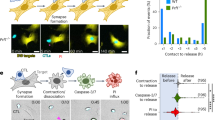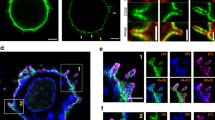Abstract
A notable feature of T lymphocyte recognition on other cell surfaces is the formation of a stable mature immunological synapse. Here we use a single-molecule labeling method to directly measure the number of ligands a cytotoxic T cell engages and track the consequences of that interaction by three-dimensional video microscopy. Like helper T cells, cytotoxic T cells were able to detect even a single foreign antigen but required about ten complexes of peptide–major histocompatibility complex (pMHC) to achieve full calcium increase and to form a mature synapse. Thus, cytotoxic T cells and helper T cells are more uniform in their antigen sensitivities than previously thought. Furthermore, only three pMHC complexes were required for killing, showing that stable synapse formation and complete signaling are not required for cytotoxicity.
This is a preview of subscription content, access via your institution
Access options
Subscribe to this journal
Receive 12 print issues and online access
$209.00 per year
only $17.42 per issue
Buy this article
- Purchase on Springer Link
- Instant access to full article PDF
Prices may be subject to local taxes which are calculated during checkout





Similar content being viewed by others
References
Bromley, S.K. et al. The immunological synapse. Annu. Rev. Immunol. 19, 375– 396 (2001).
Delon, J. & Germain, R.N. Information transfer at the immunological synapse. Curr. Biol. 10, R923– 933 (2000).
Davis, M.M. et al. Dynamics of cell surface molecules during T cell recognition. Annu. Rev. Biochem. 72, 717– 742 (2003).
Sykulev, Y., Joo, M., Vturina, I., Tsomides, T.J. & Eisen, H.N. Evidence that a single peptide-MHC complex on a target cell can elicit a cytolytic T cell response. Immunity 4, 565– 571 (1996).
Kimachi, K., Croft, M. & Grey, H.M. The minimal number of antigen-major histocompatibility complex class II complexes required for activation of naive and primed T cells. Eur. J. Immunol. 27, 3310– 3317 (1997).
Demotz, S., Grey, H.M. & Sette, A. The minimal number of class II MHC-antigen complexes needed for T cell activation. Science 249, 1028– 1030 (1990).
Harding, C.V. & Unanue, E.R. Quantitation of antigen-presenting cell MHC class II/peptide complexes necessary for T-cell stimulation. Nature 346, 574– 576 (1990).
Christinck, E.R., Luscher, M.A., Barber, B.H. & Williams, D.B. Peptide binding to class I MHC on living cells and quantitation of complexes required for CTL lysis. Nature 352, 67– 70 (1991).
Reay, P.A. et al. Determination of the relationship between T cell responsiveness and the number of MHC-peptide complexes using specific monoclonal antibodies. J. Immunol. 164, 5626– 5634 (2000).
Brower, R.C. et al. Minimal requirements for peptide mediated activation of CD8+ CTL. Mol. Immunol. 31, 1285– 1293 (1994).
Irvine, D.J., Purbhoo, M.A., Krogsgaard, M. & Davis, M.M. Direct observation of ligand recognition by T cells. Nature 419, 845– 849 (2002).
Monks, C.R., Freiberg, B.A., Kupfer, H., Sciaky, N. & Kupfer, A. Three-dimensional segregation of supramolecular activation clusters in T cells. Nature 395, 82– 86 (1998).
Grakoui, A. et al. The immunological synapse: a molecular machine controlling T cell activation. Science 285, 221– 227 (1999).
Dustin, M.L., Singer, K.H., Tuck, D.T. & Springer, T.A. Adhesion of T lymphoblasts to epidermal keratinocytes is regulated by interferon γ and is mediated by intercellular adhesion molecule 1 (ICAM-1). J. Exp. Med. 167, 1323– 1240 (1988).
Shimaoka, M. et al. Reversibly locking a protein fold in an active conformation with a disulfide bond: integrin αL I domains with high affinity and antagonist activity in vivo. Proc. Natl. Acad. Sci. USA 98, 6009– 6014 (2001).
Lu, C. et al. An isolated, surface-expressed I domain of the integrin αLβ2 is sufficient for strong adhesive function when locked in the open conformation with a disulfide bond. Proc. Natl. Acad. Sci. USA 98, 2387– 2392 (2001).
Potter, T.A., Rajan, T.V., Dick, R.F., 2nd & Bluestone, J.A. Substitution at residue 227 of H-2 class I molecules abrogates recognition by CD8-dependent, but not CD8-independent, cytotoxic T lymphocytes. Nature 337, 73– 75 (1989).
Purbhoo, M.A. et al. The human CD8 coreceptor effects cytotoxic T cell activation and antigen sensitivity primarily by mediating complete phosphorylation of the T cell receptor ζ chain. J. Biol. Chem. 276, 32786– 32792 (2001).
Wülfing, C. et al. Costimulation and endogenous MHC ligands contribute to T cell recognition. Nat. Immunol. 3, 42– 47 (2002).
van der Merwe, P.A. Do T cell receptors do it alone? Nat. Immunol. 3, 1122– 1123 (2002).
Potter, T.A., Grebe, K., Freiberg, B. & Kupfer, A. Formation of supramolecular activation clusters on fresh ex vivo CD8+ T cells after engagement of the T cell antigen receptor and CD8 by antigen-presenting cells. Proc. Natl. Acad. Sci. USA 98, 12624– 12629 (2001).
Krummel, M.F., Sjaastad, M.D., Wülfing, C. & Davis, M.M. Differential clustering of CD4 and CD3ζ during T cell recognition. Science 289, 1349– 1352 (2000).
Wülfing, C. & Davis, M.M. A receptor/cytoskeletal movement triggered by costimulation during T cell activation. Science 282, 2266– 2269 (1998).
Princiotta, M.F. et al. Quantitating protein synthesis, degradation, and endogenous antigen processing. Immunity 18, 343– 354 (2003).
Yewdell, J.W. Not such a dismal science: the economics of protein synthesis, folding, degradation and antigen processing. Trends Cell Biol. 11, 294– 297 (2001).
Alam, S.M. et al. Qualitative and quantitative differences in T cell receptor binding of agonist and antagonist ligands. Immunity 10, 227– 237 (1999).
Degano, M. et al. A functional hot spot for antigen recognition in a superagonist TCR/MHC complex. Immunity 12, 251– 261 (2000).
Stefanova, I., Dorfman, J.R. & Germain, R.N. Self-recognition promotes the foreign antigen sensitivity of naive T lymphocytes. Nature 420, 429– 434 (2002).
Ernst, B., Lee, D.S., Chang, J.M., Sprent, J. & Surh, C.D. The peptide ligands mediating positive selection in the thymus control T cell survival and homeostatic proliferation in the periphery. Immunity 11, 173– 181 (1999).
Kojima, H., Toda, M. & Sitkovsky, M.V. Comparison of Fas- versus perforin-mediated pathways of cytotoxicity in TCR- and Thy-1-activated murine T cells. Int. Immunol. 12, 365– 374 (2000).
Valitutti, S., Muller, S., Dessing, M. & Lanzavecchia, A. Different responses are elicited in cytotoxic T lymphocytes by different levels of T cell receptor occupancy. J. Exp. Med. 183, 1917– 1921 (1996).
Huppa, J.B., Gleimer, M., Sumen, C. & Davis, M.M. Continuous T cell receptor signaling required for synapse maintenance and full effector potential. Nat. Immunol. 4, 749– 755 (2003).
Huang, J.F. et al. TCR-mediated internalization of peptide-MHC complexes acquired by T cells. Science 286, 952– 954 (1999).
Stinchcombe, J.C., Bossi, G., Booth, S. & Griffiths, G.M. The immunological synapse of CTL contains a secretory domain and membrane bridges. Immunity 15, 751– 761 (2001).
Pear, W.S., Nolan, G.P., Scott, M.L. & Baltimore, D. Production of high-titer helper-free retroviruses by transient transfection. Proc. Natl. Acad. Sci. USA 90, 8392– 8396 (1993).
Wülfing, C., Sjaastad, M.D. & Davis, M.M. Visualizing the dynamics of T cell activation: intracellular adhesion molecule 1 migrates rapidly to the T cell/B cell interface and acts to sustain calcium levels. Proc. Natl. Acad. Sci. USA 95, 6302– 6307 (1998).
Acknowledgements
We thank J. Chen and H. Eisen for the 2C cytotoxic T cell clone and M.S. Kuhns for providing the pMSCV-Z4 retroviral vector. Supported by the National Institutes of Health (M.M.D.), Howard Hughes Medical Institute (M.A.P.), Cancer Research Fund of the Damon Runyon-Walter Winchell Foundation Fellowship (D.J.I.) and Cancer Research Institute (J.B.H.).
Author information
Authors and Affiliations
Corresponding author
Ethics declarations
Competing interests
The authors declare no competing financial interests.
Rights and permissions
About this article
Cite this article
Purbhoo, M., Irvine, D., Huppa, J. et al. T cell killing does not require the formation of a stable mature immunological synapse. Nat Immunol 5, 524–530 (2004). https://doi.org/10.1038/ni1058
Received:
Accepted:
Published:
Issue Date:
DOI: https://doi.org/10.1038/ni1058
This article is cited by
-
Who wins the combat, CAR or TCR?
Leukemia (2023)
-
T cell receptor therapeutics: immunological targeting of the intracellular cancer proteome
Nature Reviews Drug Discovery (2023)
-
SARS-CoV-2 reservoir in post-acute sequelae of COVID-19 (PASC)
Nature Immunology (2023)
-
A bead-based method for high-throughput mapping of the sequence- and force-dependence of T cell activation
Nature Methods (2022)
-
Advances in NK cell production
Cellular & Molecular Immunology (2022)



